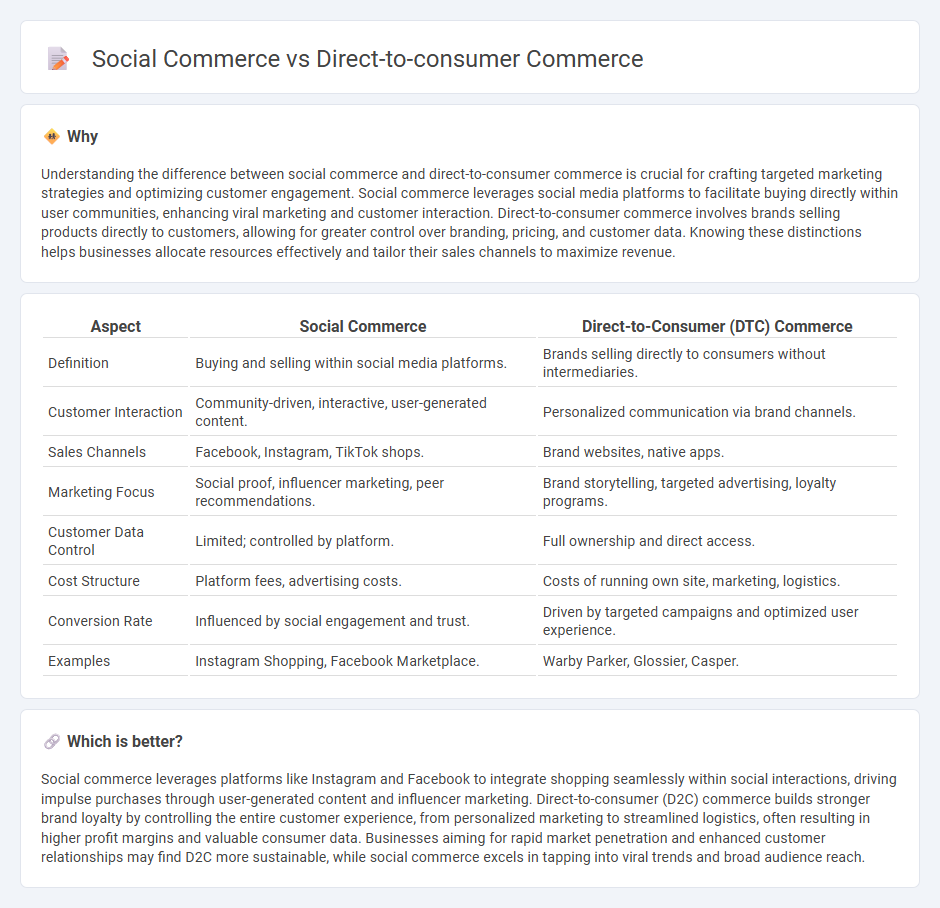
Social commerce leverages social media platforms to facilitate shopping experiences directly within apps like Instagram and Facebook, driving customer engagement and seamless transactions. Direct-to-consumer (DTC) commerce bypasses traditional retail channels, allowing brands to sell products straight to customers via their own websites, enhancing brand control and customer relationships. Explore deeper insights into how these commerce models reshape retail strategies and consumer behavior.
Why it is important
Understanding the difference between social commerce and direct-to-consumer commerce is crucial for crafting targeted marketing strategies and optimizing customer engagement. Social commerce leverages social media platforms to facilitate buying directly within user communities, enhancing viral marketing and customer interaction. Direct-to-consumer commerce involves brands selling products directly to customers, allowing for greater control over branding, pricing, and customer data. Knowing these distinctions helps businesses allocate resources effectively and tailor their sales channels to maximize revenue.
Comparison Table
| Aspect | Social Commerce | Direct-to-Consumer (DTC) Commerce |
|---|---|---|
| Definition | Buying and selling within social media platforms. | Brands selling directly to consumers without intermediaries. |
| Customer Interaction | Community-driven, interactive, user-generated content. | Personalized communication via brand channels. |
| Sales Channels | Facebook, Instagram, TikTok shops. | Brand websites, native apps. |
| Marketing Focus | Social proof, influencer marketing, peer recommendations. | Brand storytelling, targeted advertising, loyalty programs. |
| Customer Data Control | Limited; controlled by platform. | Full ownership and direct access. |
| Cost Structure | Platform fees, advertising costs. | Costs of running own site, marketing, logistics. |
| Conversion Rate | Influenced by social engagement and trust. | Driven by targeted campaigns and optimized user experience. |
| Examples | Instagram Shopping, Facebook Marketplace. | Warby Parker, Glossier, Casper. |
Which is better?
Social commerce leverages platforms like Instagram and Facebook to integrate shopping seamlessly within social interactions, driving impulse purchases through user-generated content and influencer marketing. Direct-to-consumer (D2C) commerce builds stronger brand loyalty by controlling the entire customer experience, from personalized marketing to streamlined logistics, often resulting in higher profit margins and valuable consumer data. Businesses aiming for rapid market penetration and enhanced customer relationships may find D2C more sustainable, while social commerce excels in tapping into viral trends and broad audience reach.
Connection
Social commerce and direct-to-consumer (DTC) commerce both leverage digital platforms to create personalized shopping experiences, enabling brands to engage directly with consumers without intermediaries. Social commerce integrates shopping features within social media channels like Instagram, Facebook, and TikTok, facilitating seamless product discovery and purchase through user-generated content and influencer marketing. DTC commerce complements this by focusing on brand-owned websites or apps that provide control over customer data, personalized marketing, and streamlined supply chains, strengthening customer relationships and boosting sales.
Key Terms
Sales Channels
Direct-to-consumer (DTC) commerce leverages brand-owned websites and apps to sell products directly to customers, ensuring full control over branding, customer experience, and data collection. Social commerce integrates sales within social media platforms like Instagram, Facebook, and TikTok, enabling seamless shopping experiences through embedded product tags and shoppable posts. Explore how these distinctive sales channels shape consumer engagement and drive revenue growth.
Customer Data Ownership
Direct-to-consumer commerce empowers brands with complete customer data ownership, enabling personalized marketing and enhanced customer experiences by collecting first-party data directly from buyers. Social commerce platforms often limit data access, sharing only aggregated insights while retaining control over detailed user information, which restricts brands' ability to fully leverage customer analytics. Explore how optimizing customer data ownership can transform your marketing strategy and drive growth.
Platform Dependency
Direct-to-consumer commerce minimizes platform dependency by channeling sales through brand-owned websites, ensuring full control over customer data and user experience. Social commerce relies heavily on platforms like Instagram, Facebook, and TikTok, which can limit data access and subject businesses to algorithm changes. Explore how platform dependency shapes strategies in each commerce model for a competitive edge.
Source and External Links
Direct-to-consumer - Wikipedia - Direct-to-consumer (DTC) is a business model where companies sell products directly to customers bypassing any third-party retailers or middlemen, commonly done online but also via physical retail complementary to e-commerce, with U.S. DTC e-commerce sales exceeding $128 billion in 2021.
Direct to Consumer (DTC) Sales: Tips and Examples to Sell More - DTC sales involve brands selling straight to end customers without intermediaries, giving companies full control over branding, customer data, personalized marketing, and enabling higher profit margins while strengthening customer relationships.
How the Direct-to-Consumer (DTC) Business Model Works - The direct-to-consumer ecommerce model sells products directly to consumers by bypassing wholesalers, retailers, and platforms, allowing brands to save costs and potentially offer lower prices relative to traditional B2C models that use retail or wholesale channels.
 dowidth.com
dowidth.com